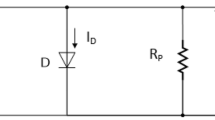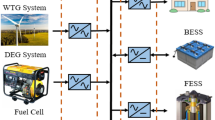Abstract
Maximum power point tracking (MPPT) is used in photovoltaic (PV) systems to maximize its output power. This paper introduces a new MPPT control design to PV system supplied switched reluctance motor (SRM) based on PI controller. The developed PI controller is used to reach MPPT by monitoring the voltage and current of the PV array and adjusting the duty cycle of the DC/DC converter. The design task of MPPT is formulated as an optimization problem which is solved by BAT algorithm to search for optimal parameters of PI controller. Simulation results have shown the validity of the suggested technique in delivering MPPT to SRM under atmospheric conditions. Also, the performance of the developed BAT algorithm is compared with particle swarm optimization for various disturbances to confirm its robustness.






















Similar content being viewed by others
References
Sen Z (2008) Solar energy fundamentals and modeling technique. Springer, Berlin
Krauter SCW (2006) Solar electric power generation-photovoltaic energy system. Springer, Berlin
da Rosa AV (2005) Fundamentals of renewable energy processes. Elsevier, Amsterdam
Wurfel P (2005) Physics of solar cells from principles to new concept. Wiley, New York
Veerachary M, Seniyu T, Uezato K (2001) Maximum power point tracking control of IDB converter supplied PV system. IEE Proc Electron Power Appl 148(6):494–502
Armstrong S, Hurley W (2004) Self regulating maximum power point tracking for solar energy systems. In: 39th international universities power engineering conference. UPEC, Bristol, UK, pp 604–609
Piegari L, Rizzo R (2010) Adaptive perturb and observe algorithm for photovoltaic maximum power point tracking. IET Renew Power Gener 4(4):317–328
Brambilla A, Gambarara M, Garutti A, Ronchi F (1999) New approach to photovoltaic arrays maximum power point tracking. In: 30th annual IEEE power electronics specialists conference (PESC 99), vol 2, pp 632–637
Hohm DP, Ropp ME (2000) Comparative study of maximum power point tracking algorithm using an experimental programmable, maximum power point tracking test bed. In: Proceedings 28th IEEE photovoltaic specialist conference, pp 1699–1702
Swiegers W, Enslin J (1998) An integrated maximum power point tracker for photovoltaic panels. In: Proceedings IEEE international symposium on industrial electronics, vol 1, pp 40–44
Oshiro M, Tanaka K, Senjyu T, Toma S, Atsushi Y, Saber A, Funabashi T, Kim C (2011) Optimal voltage control in distribution systems using PV generators. Int J Electr Power Energy Syst 33(3):485–492
Hui J, Sun X (2010) MPPT strategy of PV system based on adaptive fuzzy PID algorithm. In: International conference on life system modeling and simulation, LSMS 2010, and international conference on intelligent computing for sustainable energy and environment, ICSEE, vol 97, pp 220–228
Ouada M, Meridjet M, Saoud M, Talbi N (2013) Increase efficiency of photovoltaic pumping system based BLDC motor using fuzzy logic MPPT control. WSEAS Trans Power Syst 8(3):104–113
AI-Amoudi A, Zhang L (2000) Application of radial basis function networks for solar-array modeling and maximum power-point prediction. IEE Proc Gener Transm Distrib 147(5):310–316
Bahgat ABG, Helwa NH, Ahmad GE, El Shenawy ET (2005) Maximum power point tracking controller for pv systems using neural networks. Renew Energy 30(8):1257–1268
Zhang H, Cheng S (2011) A new MPPT algorithm based on ANN in solar PV systems. Adv Comput Commun Control Autom LNEE 121:77–84
Younis MA, Khatib T, Najeeb M, Ariffin AM (2012) An improved maximum power point tracking controller for PV systems using artificial neural network. Przeglad Elektrotechniczny 88(3b):116–121
Ishaque K, Salam Z (2011) An improved modeling method to determine the model parameters of photovoltaic (PV) modules using differential evolution (DE). Sol Energy 85:2349–2359
Ishaque K, Salam Z, Taheri H, Shamsudin A (2011) A critical evaluation of EA computational methods for photovoltaic cell parameter extraction based on two diode model. Sol Energy 85:1768–1779
Ramaprabha R, Gothandaraman V, Kanimozhi K, Divya R, Mathur BL (2011) Maximum power point tracking using GA optimized artificial neural network for solar PV system. In: IEEE international conference on electrical energy systems, pp 264–268
Benyoucef A, Chouder A, Kara K, Silvestre S, Sahed O (2015) Artificial bee colony based algorithm for maximum power point tracking (MPPT) for PV systems operating under partial shaded conditions. Appl Soft Comput 32:38–48
Oshaba AS, Ali ES, Abd Elazim SM (2015) PI Controller design using artificial bee colony algorithm for MPPT of photovoltaic system supplied DC motor-pump load. Complexity. doi:10.1002/cplx.21670
Pooja B, Dub SS, Singh JB, Lehana P (2013) Solar power optimization using BFO algorithm. Int J Adv Res Comput Sci Softw Eng 3(12):238–241
Oshaba AS, Ali ES (2014) Bacteria foraging: a new technique for speed control of DC series motor supplied by photovoltaic system. Int J WSEAS Trans Power Syst 9:185–195
Yang XS (2011) BAT algorithm for multiobjective optimization. Int J Bio-Inspir Comput 3(5):267–274
Bora TC, Coelho LS, Lebensztajn L (2012) BAT-inspired optimization approach for the brushless DC wheel motor problem. IEEE Trans Magn 48(2):947–950
Yang XS, Gandomi AH (2012) BAT algorithm: a novel approach for global engineering optimization. Eng Comput 29(5):464–483
Rakesh V, Aruna SB, Raju TD (2013) Combined economic load and emission dispatch evaluation using BAT algorithm. Int J Eng Res Appl 3(3):1224–1229
Ramesh B, Mohan VCJ, Reddy VCV (2013) Application of BAT algorithm for combined economic load and emission dispatch. Int J Electr Electron Eng Telecommun 2(1):1–9
Yang Xin-She (2013) BAT algorithm: literature review and applications. Int J Bio-Inspir Comput 5(3):141–149
Biswal S, Barisal AK, Behera A, Prakash T (2013) Optimal power dispatch using BAT algorithm. In: International conference on energy efficient technologies for sustainability (ICEETS), pp 1018–1023
Rodrigues D, Pereira LAM, Nakamura RYM, Costa KAP, Yang XS, Souza AN, Papa JP (2014) A wrapper approach for feature selection based on BAT algorithm and optimum-path forest. Expert Syst Appl 41(5):2250–2258
Reddy PSK, Kumar PA, Vaibhav GNS (2015) Application of BAT algorithm for optimal power dispatch. Int J Innov Res Adv Eng 2(2):113–119
Ali ES (2014) Optimization of power system stabilizers using BAT search algorithm. Int J Electr Power Energy Syst 61:683–690
Krishnan R (2001) Switched reluctance motor drives modeling, simulation, analysis, design, and applications. CRC Press, Boca Raton
Kalaivani L, Subburaj P, Iruthayarajan MW (2013) Speed control of switched reluctance motor with torque ripple reduction using non-dominated sorting genetic algorithm (NSGA-II). Int J Electr Power Energy Syst 53:69–77
Daryabeigi E, Dehkordi BM (2014) Smart bacterial foraging algorithm based controller for speed control of switched reluctance motor drives. Int J Electr Power Energy Syst 62:364–373
Oshaba AS (2013) Performance of a sensorless SRM drive fed from a photovoltaic system. Res J Appl Sci Eng Technol 6(17):3165–3173
Oshaba AS, Ali ES, Abd-Elazim SM (2015) ACO based speed control of SRM fed by photovoltaic system. Int J Electr Power Energy Syst 67:529–536
Bose BK (2002) Modern power electronics and AC drives. Prentice-Hall, New Jersey
Oshaba AS, Ali ES, Abd-Elazim SM (2014) Speed control of switched reluctance motor fed by PV system using ant colony optimization algorithm. Int J WSEAS Trans Power Syst 9:376–387
Mehta R, Mehta VK (2013) Principles of electrical machines, 2nd edn. S. Chand, New Delhi
Hussein K, Muta I, Hoshino T, Oskada M (1995) Maximum photovoltaic power tracking: an algorithm for rapidly changing atmospheric conditions. IEE Proc Gener Transm Distrib 142(1):59–64
Jaboori MG, Saied MM, Hanafy AA (1991) A contribution to the simulation and design optimization of photovoltaic systems. IEEE Trans Energy Convers 6(3):401–406
Hua C, Shen C (1997) Control of DC/DC converters for solar energy system with maximum power tracking. In: 23rd international conference on industrial electronics, control and instrumentation, IECON’97, vol 2, pp 827–832
Liu X, Lopes LAC (2004) An improvement perturbation and observation maximum power point tracking algorithm for PV arrays. In: Power electronics specialists conference, PESC’04, vol 3, pp 2005–2010
Nafeh AA, Fahmy FH, Mahgoub OA, El-Zahab EM (1998) Developed algorithm of maximum power tracking for stand-alone photovoltaic system. Energy Sour 20:45–53
Yu GJ, Jung YS, Choi JY, Kim GS (2004) A novel two-mode MPPT control algorithm based on comparative study of existing algorithms. Sol Energy 76(4):445–463
Cheikh MSA, Larbes C, Kebir GFT, Zerguerras A (2007) Maximum power point tracking using fuzzy logic control scheme. Revue des Energies Renouvelables 10(3):387–395
Amrouche B, Belhamel M, Guessomm A (2007) Artificial Intelligence based MPPT method for photovoltaic systems. Revue des Energies Renouvelables, ICRESD-07 Tlemcen, pp 11–16
Oshaba AS, Ali ES, Abd-Elazim SM (2014) MPPT control design of PV generator powered DC motor-pump system based on artificial bee colony algorithm. J Electr Eng 14(4):315–324
Kennedy JF, Kennedy J, Eberhart RC, Shi Y (2001) Swarm Intelligence, 1st edn. Morgan Kaufmann, San Francisco
Oshaba AS, Ali ES (2013) Speed control of induction motor fed from wind turbine via particle swarm optimization based PI controller. Res J Appl Sci Eng Technol 5(18):4594–4606
Oshaba AS, Ali ES (2013) Swarming speed control for DC permanent magnet motor drive via pulse width modulation technique and DC/DC converter. Res J Appl Sci Eng Technol 5(18):4576–4583
Mahendiran TV, Thanushkodi K, Thangam P (2012) Speed control of switched reluctance motor using new hybrid particle swarm optimization. J Comput Sci 8(9):1473–1477
Ali ES, Abd-Elazim SM (2013) Power system stability enhancement via bacteria foraging optimization algorithm. Int Arab J Sci Eng 38(3):599–611
Abd-Elazim SM, Ali ES (2013) Synergy of particle swarm optimization and bacterial foraging for TCSC damping controller design. Int J WSEAS Trans Power Syst 8(2):74–84
Author information
Authors and Affiliations
Corresponding author
Appendix
Appendix
-
(a)
SRM parameters [38, 39]: N s = 8, N r = 6, rating speed = 13,700 rpm, C r = 0.8, q = 4, Phase resistance of stator = 17 Ω, Phase inductance of aligned position = 0.605 H, Phase inductance of unaligned position = 0.1555 H, Step angle = 15°.
-
(b)
PV parameters: A = 1.2153; E g = 1.11; I or = 2.35e−8; I sc = 4.8; T r = 300; K = 1.38e−23; n s = 36; q o = 1.6e−19; k i = 0.0021.
-
(c)
The parameters of BAT search algorithm are as follows: Max generation = 100; population size = 50; β = γ = 0.9, L min = 0; L 0 = 1, f min = 0; f max = 100.
-
(d)
PSO parameters: Max generation = 100; No. of Population in swarm = 50; C 1 = C 2 = 2; ω = 0.9.
Rights and permissions
About this article
Cite this article
Oshaba, A.S., Ali, E.S. & Abd Elazim, S.M. PI controller design for MPPT of photovoltaic system supplying SRM via BAT search algorithm. Neural Comput & Applic 28, 651–667 (2017). https://doi.org/10.1007/s00521-015-2091-9
Received:
Accepted:
Published:
Issue Date:
DOI: https://doi.org/10.1007/s00521-015-2091-9




